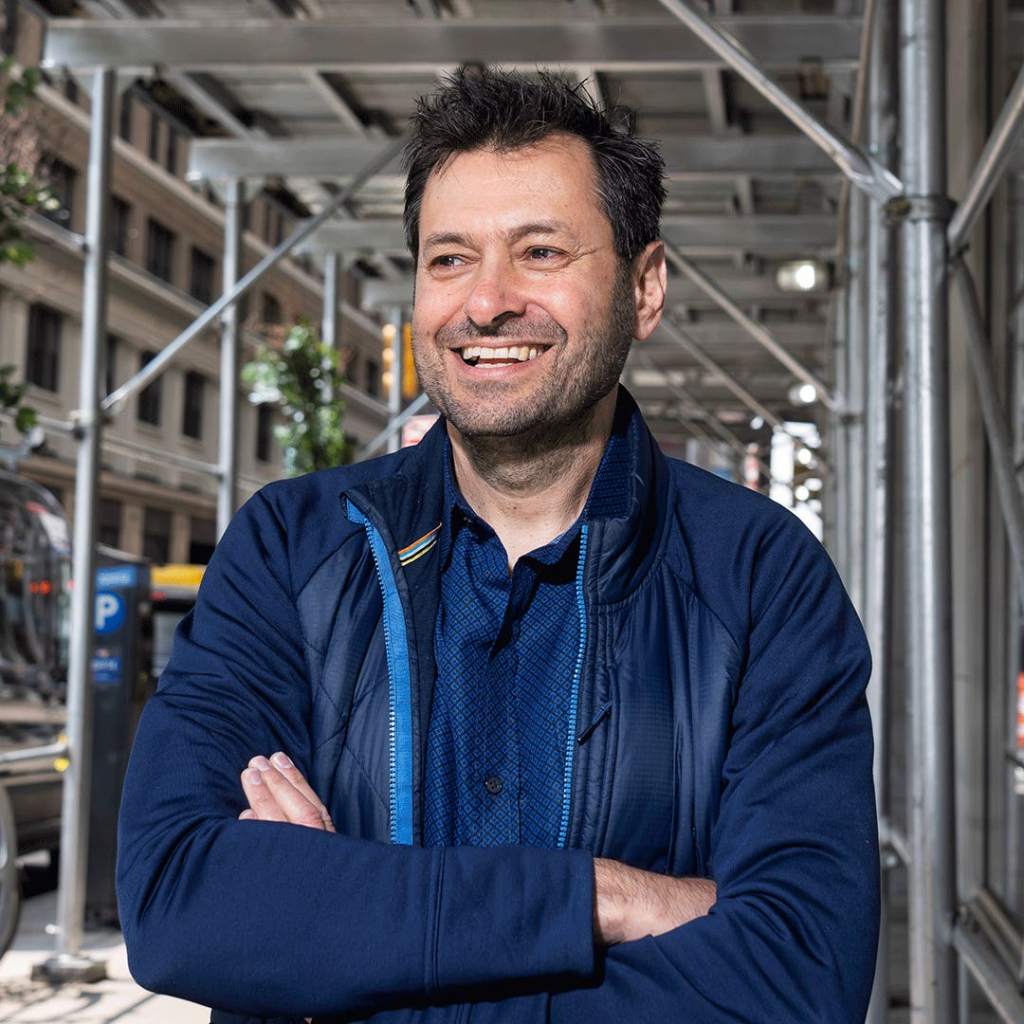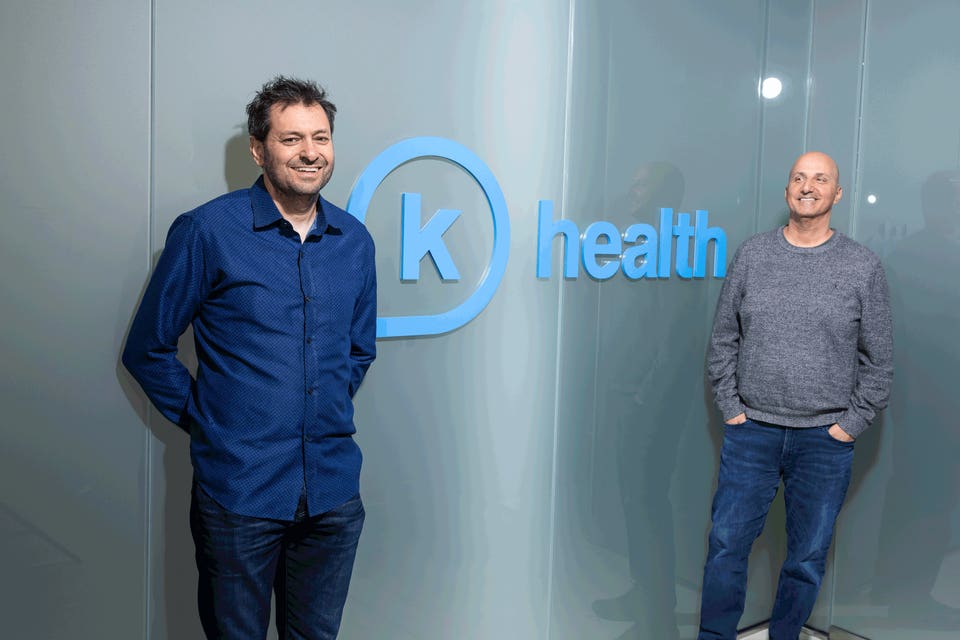With millions of patients under its belt, digital health startup K Health is looking to scale its artificial intelligence technology in hospitals, starting with new strategic investor Cedars-Sinai.

The problem with turning to the internet for medical advice is that you can come away thinking that you either have a headache or a brain tumor – but the reality is you probably just have a headache. With K Health, Allon Bloch is creating an antidote to “Dr. Google” that ingests your symptoms and medical history via an AI-powered chatbot, sifts through the data of millions of patients and suggests a medical condition based on how you compare to other people like you. “We’re trying to mimic the best doctor in the world,” says Bloch, 53, cofounder and CEO of the seven-year-old New York-based startup.
Training machines to imitate the decision-making process of a doctor, while a significant technical feat, is still a far cry from robots taking over medicine. For now, K Health’s technology is essentially functioning as a digital assistant. “Doctors spend a lot of time collecting information from forms asking basic questions that machines can do,” says Bloch. The average patient answers around 25 questions from K Health’s chatbot in less than five minutes. The bot itself can’t give medical advice, but it gives patients the option of connecting with a human doctor or nurse, who takes over the chat. On the backend, the human clinician sees a summary and suggestions of potential diagnoses, relieving them of the burden of rushing through intake and entering data into the electronic medical record. “It’s available 24/7,” says Bloch. “It’s not rushing to go home. It’s never seen too many patients.”
Bloch says more than 3.1 million patients in 48 states have completed a chat with a doctor or nurse visit via K Health (medical visits are not available in Alaska or Hawaii). The company offers primary care, urgent care and some pediatric services, as well as chronic disease treatment, including weight loss management. Last year, Bloch says K Health had $US52 million in revenue, though the company is not yet profitable. He says around 40% of K Health’s business is direct-to-consumer and the rest is through enterprise contracts, including with the insurer Elevance Health (formerly known as Anthem).
After creating a national footprint, the next step in K Health’s strategy is to go local: working with hospital customers to serve as an entry point for new and existing patients to be looped into a bigger system of care. K Health closed a partnership deal with southern California-based health system Cedars-Sinai last week to use its technology for virtual urgent and primary care services. Cedars-Sinai is also joining as a strategic investor in a $US59 million funding round, alongside existing investors Valor Equity Partners, Mangrove Capital Partners and Pico Venture Partners. Bloch declined to disclose the valuation of this round. K Health last raised a $US132 million Series E at a $US1.5 billion valuation in 2021. Based on market conditions that have depressed the value of many unicorns over the past year, Forbes estimates K Health’s current valuation to be around $US800 million.
Shlomo Melmed, executive vice president of academic affairs and dean of the medical faculty at Cedars-Sinai, says K Health fits into the health system’s broader strategic plan around digitization. While Cedars-Sinai excels at some of the most complex aspects of medicine – heart transplants, neurosurgery, cancer care, Melmed says primary care remains a challenge for most large academic medical centers. He rattles off a number of reasons for this, including a shortage of doctors, high levels of burnout, insurance reimbursement issues and access. “It’s sort of counterintuitive,” he says. “For serious illness, we are so effective, and yet, for the common ailments, we have so many logistical challenges.”
With the K Health partnership, both existing and new patients will be able to use an app that connects to K Health’s AI and leads to a chat with a Cedars-Sinai credentialed doctor or nurse. The app, which is expected to go live by the end of this year, will also be linked into the system’s electronic medical record system from Epic, sparing patients the tedium of filling out multiple forms with the same information. That doctor will also be able to make referrals within the brick-and-mortar Cedars-Sinai network for any needed specialty care.
Melmed says any use of artificial intelligence at Cedars-Sinai is reviewed by an internal committee to examine all of the ethical implications. And with this partnership, like all the others, he says the ultimate decision to diagnose and treat will remain with the clinician. Melmed says he can’t predict how many patients will end up using it but is optimistic: “There are 25 million people in Southern California and we have difficult access to primary care, so the potential is huge.”

Bloch says he first started thinking about challenges around data and medicine when his father, who had been diagnosed with an irregular heartbeat, experienced a stroke after the anticoagulant medication he was taking failed. Doctors had been regularly checking his dad’s blood clot levels, but Bloch felt like everyone involved would have benefitted from bigger-picture data, such as how other similar patients had responded to the same drug. Bloch had never worked for a healthcare company before; he had been an investor at Jerusalem Venture Partners and 83 North (formerly Greylock Israel), co-CEO of web software developer Wix and cofounder and CEO of online car retailer startup Vroom. Nevertheless, after a dispute with Vroom’s investors over the future direction of the company, he left the role in 2016 to start K Health.
The cofounding team included chief product officer Ran Shaul, chief technology officer Israel Roth (who retired last year) and Adam Singolda, CEO of internet advertising company Taboola, who is on K Health’s board. While the cofounders first hashed out their idea for the company in the summer of 2016, the building of the AI models couldn’t start until they got their hands on the right healthcare data, says Shaul, 50. Most of the available datasets to license in the United States were insurance billing data without detailed medical notes. Instead, they turned to their native Israel, where Bloch says patients tend to stick with the same insurance company for most of their lives–this provided a long-term look at diagnoses and treatments in a single patient. They were able to license a dataset from the Israeli health insurance company Maccabi that included anonymized health data of 2.1 million people over 20 years, including 400 million medical charts, 2 million hospitalizations, 500 million prescriptions and over a billion lab results.
At that point, Shaul says they built a language model, similar to the technology that powers OpenAI’s viral chatbot ChatGPT. The main difference is that K Health’s model was trained on smaller, specific healthcare datasets and not the entirety of the open internet. When a human types a prompt into ChatGPT, it can generate a poem or screenplay. When a patient types a symptom into K Health, such as “headache,” the AI responds with a series of questions – Is the pain in the front or the side? – as it winnows down the statistical likelihood of related conditions based on gender, age, medical history and symptoms.
A retrospective study of K Health patient visits found that the human doctors and nurses agreed with one of the AI-recommended diagnoses 84.2% of the time.
One of the key innovations, Shaul says, is being able to predict “the next best question” to ask the patient, which requires layers of specialized algorithms on top of the language model. It is continually retrained on new data collected from patient chats and feedback from K Health’s clinicians. In some cases, K Health’s AI may not be able to predict a diagnosis, Bloch says, but it won’t make up a fake disease that doesn’t exist.
K Health first launched in the U.S. in the summer of 2018 as a free app that people could use as a symptom checker. In 2019, the company launched direct-to-consumer medical services with three doctors in two states, meaning patients could pay for chats to get diagnosis and treatment. By 2021, K Health could connect patients with doctors in 48 states. That year the company also entered into a joint venture with Elevance Health and Blackstone called Hydrogen Health, which sells K Health’s technology to health insurers. Bloch says Hydrogen has received around $US100 million in investment.
Since the symptom checker was first launched, Bloch says more than 10 million people have interacted with K Health’s AI, and 3.1 million of them have elected to have a chat with a doctor or nurse. He says nowadays around 70% of people who start a conversation with K Health’s AI complete a chat-based medical visit.
Not all customers are satisfied. Negative reviews on sites, including TrustPilot and the Better Business Bureau, have several recurring themes: patients who are frustrated they couldn’t be treated online and were told to seek in-person care and patients who were denied antibiotics. Stephanie Foley, a family medicine doctor and director of performance at K Health, says the low rate of antibiotic prescriptions is intentional. Most coughs and colds are caused by viruses, which make antibiotics ineffective, despite the fact that urgent care centers and doctor’s offices frequently, but inappropriately, prescribe them for these illnesses. As for the customers who are angry they paid money only to be told they need to see someone in person, Bloch says getting a referral to the ER, urgent care or a specialist is still performing a medical service. He says K Health ends up issuing customer refunds around 5% of the time. “What’s your chance of getting a refund if you go into a clinic and you see a doctor and you say I don’t like my doctor?”
PERCENTAGE OF CASES WHERE DOCTORS CHOSE ONE OF THE AI’S RECOMMENDATIONS
- Bladder infection: 98.9%
- Pink eye: 98.7%
- Common cold: 97.3%
- Skin rash: 42.4%
- Asthma: 32.9%
- Abdominal pain: 20.8%
All of the data collected from the symptom checker and visits is anonymized to protect privacy and used to retrain K Health’s algorithms. The chats with a doctor or nurse fall under the federal patient privacy law HIPAA. Bloch says none of the data people have entered into the app or website has been shared with third-party tracking services or social media companies. In addition to the Maccabi dataset, K Health also licensed another large anonymized dataset from the Mayo Clinic in 2020, which included anonymized medical charts from 5.3 million patients,1.2 million lab tests and partial data tied to another 4.7 million patients. With that data, K Health has started developing predictive algorithms targeted towards helping doctors personalize hypertension treatments based on how other patients of similar gender, age, medical history, ethnicity and blood pressure have responded.
K Health has been working with academic researchers to evaluate the accuracy of its AI. When the doctor or nurse takes over the chat, they’re given a summary of the conversation and a list of up to 5 potential diagnoses. A retrospective study of more than 100,000 K Health patient visits between October 2022 and January 2023 found that the human doctors and nurses agreed with one of the AI-recommended diagnoses 84.2% of the time and with the top-ranked AI diagnosis 60.9% of the time. The study has not yet been peer-reviewed. “I was worried that because physicians see the diagnostic prediction, they might over rely on it,” says Dan Zeltzer, an economics professor at Tel Aviv University who studies healthcare decision-making and was the lead author of the study. Zeltzer, who has worked as a consultant for K Health, says he tested this by blinding a subset of 220 cases, meaning the reviewing doctors weren’t provided with the AI recommendations. “We saw it wasn’t an issue.”
The app is better at some conditions than others. The study found high levels of accuracy for bladder infections and pink eye, but it was significantly less accurate for issues involving symptoms of skin rashes and abdominal pain. Zeltzer says he can only speculate as to why the AI performed better on some conditions and not on others as it was outside the scope of what was analyzed in the study. “But the general pattern must have to do with the availability of data,” he says.
When it comes to implementing AI into medical practice, two of the most important factors are the safety of the patients and building trust among medical providers, says Jon Ebbert, an internal medicine doctor and professor of medicine at the Mayo Clinic, who was involved with the study. Even as AI models are validated and retrained with more data, there will never be 100% accuracy. Ebbert says he likes the idea of using AI to help speed up the routine intake process for common, low-risk conditions, such as a urinary tract infection, so that he can recommend a diagnosis faster and focus on the more complex aspects of medicine. “That’s the work that needs to be done in these spaces,” he says. “What are the clinical conditions that are right for a digital practice partner to assist me? And what are the ones that I don’t really think it’s appropriate to deploy?”
For now, Bloch says K Health will continue to refine its models and build new ones. By this stage, two of his previous companies — Vroom and Wix (where he sits on the board of directors) — had already IPOed after 6 or 7 years of building. But he recognizes that the healthcare industry is more complicated and will take longer. As far as where the technology is headed: “Now in the future, is there a possibility to fully automate certain diagnosis and treatment? I think so down the road,” Bloch says. “But we’re not ready for it yet.”
This article was first published on forbes.com and all figures are in USD.


